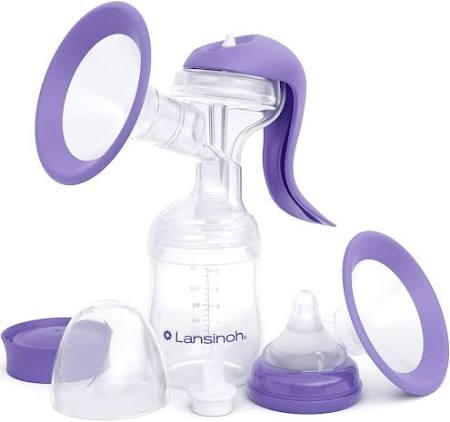When breastfeeding, pumping is an important skill to utilize! There are many reasons for expressing milk: difficulties establishing breastfeeding, separation from the baby, illness, and donation. Expressing breast milk when the baby is not nursing at the breast aids in protecting one’s milk supply and allows the baby to be fed milk regardless of who they are in the care of at the time of feedings.

Timing and frequency will change depending on the goal of expressing/pumping:
Full-Time Work/School: Pump at the time of the missed feedings.
Occasional Separation: Early mornings are best. This is when the body produces the largest quantity of milk, making it easier to express/pump a quantity conducive to a missed feeding.
Establishing a Milk Supply: Recommended 8-10 times during the day. It is recommended to wait 4-5 hours in between nighttime pumping sessions.
Donation: If pumping for donation, pump when it is convenient and will not disrupt your baby’s normal feeding routine.
There are multiple ways to express/pump. Different options work better for different people.
Hospital-Grade Pumps: These types of pumps closely resemble the suction provided by the newborn and, therefore are critical when establishing supply. For someone who is exclusively pumping, this is going to be the most effective option. They are the most expensive option for a pump. They can be rented out from hospitals for single or long-term use.
Double Electric Pump: This type of pump is similar to a hospital-grade pump, but is an option that is more affordable. They traditionally come with a wall plug-in as well as a battery pack for on-the-go use. They can provide automatic suction to both breasts at the same time or just one side depending on your need. Some insurance will compensate for the cost of purchasing a double electric pump. Some available brands that offer these styles of pumps are Medela, Lansinoh, Philips AVENT, and Spectra Baby.
Manual Pumps: Hand-held breast pumps are a great option for on-the-go. They are purely manual, which means that they would work in any circumstance. These types of pumps are intended to be used on one breast at a time, but can also be easily used while nursing on the other side. Some available brands that offer these styles of pumps are Haakaa, Medela, and Lansinoh.
Hand Expression: This is an option of expressing that relies on no equipment. Should you forget a pump, or should your nipples become tender to the point of extreme discomfort, this would be a great option. Below is a picture diagram of how to properly hand express. This method would be the most challenging as far as triggering a letdown, which means that quantity may be a problem with hand expression. This method would work well if your breasts/chest was already engorged, or if you had your baby nursing on the other side.
Check out the link below to visit a website named AeroFlow, which works with insurance to cover the cost of name-brand breast pumps and then will mail one right to your door!
Tips and Tricks for a Successful Pumping Session:
Relax! Get comfortable on the couch or in your favorite chair. Pumping can not be rushed so you might as well enjoy the time that you have and kick your feet up.
Either pump while simultaneously nursing or pump on both breasts simultaneously. This can lead to a higher milk yield per pumping session.
Pump until experiencing a letdown. This will aid in larger quantities of milk. Some ways to assist in this happening would be to look at pictures of your baby or to bring a blanket that smells like your baby. Both of these actions would help with the production of oxytocin, which helps trigger a letdown.
Keep in mind that not every person can pump large quantities. This does not reflect the quantity that your baby is receiving per nursing session. Babies are much more effective on the breast than the pump.
How to Safely Store and Use Pre-Pumped Breastmilk:
Freshly Expressed or Pumped:
Countertop (77°F (25°C) or colder): Up to 4 Hours
Refrigerator (40°F (4°C): Up to 4 Days
Freezer (0°F (-18°C) or colder): Within 6 months is best, up to 12 months is acceptable
Thawed, Previously Frozen:
Countertop (77°F (25°C) or colder): 1–2 Hours
Refrigerator (40°F (4°C): Up to 1 Day (24 hours)
Freezer (0°F (-18°C) or colder): NEVER refreeze breast milk after it has been thawed
Leftovers from a Feeding (baby did not finish the bottle):
Countertop (77°F (25°C) or colder): Use within 2 hours after the baby is finished feeding
Refrigerator (40°F (4°C): Use within 2 hours after the baby is finished feeding
Freezer (0°F (-18°C) or colder): Only freshly expressed milk is able to safely be stored in the freezer.
(CDC, 2021)
How to Properly Thaw Frozen Breast Milk
The best way to dethaw breast milk is the night before it is needed, in the refrigerator. If needed right away, thaw under lukewarm water. After it is thawed, follow the instructions above on how long it can be used before no longer being a safe option for your baby.
Thawing or warming breastmilk in a microwave is not recommended. Microwaves heat liquids unevenly and form hot spots. This can burn your baby’s mouth and destroy the immune components in breast milk (Mohrbacher, 2020).
Sources:
Mohrbacher, N. (2020). Breastfeeding Answers: A Guide for Helping Families (2nd ed.). Nancy Mohrbacher Solutions, Inc.
Proper Storage and Preparation of Breast Milk. (2021, June 11). Centers for Disease Control and Prevention. https://www.cdc.gov/breastfeeding/recommendations/handling_breastmilk.htm
-2_.jpg)






Comments